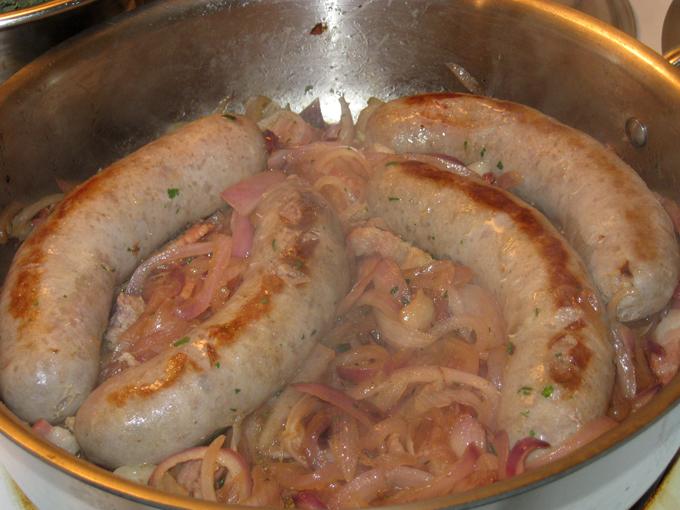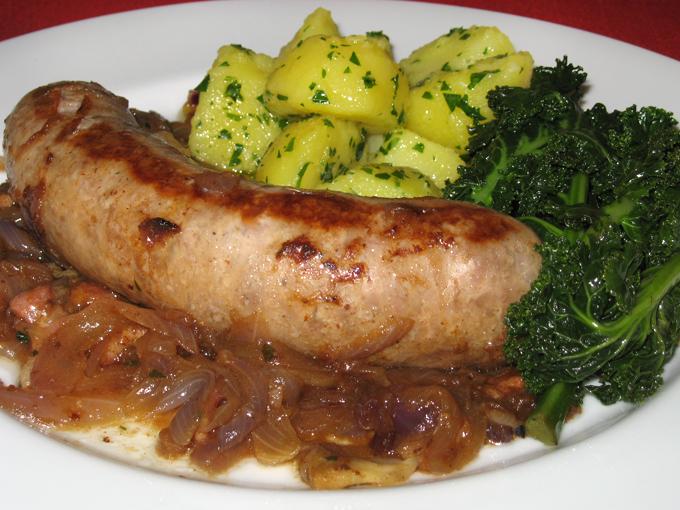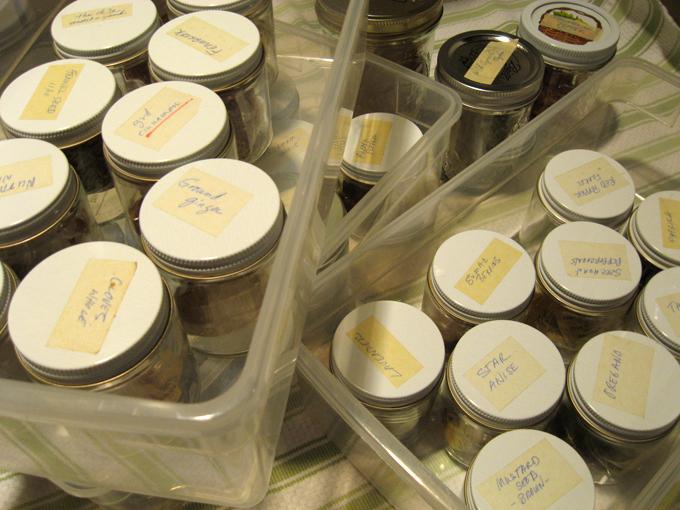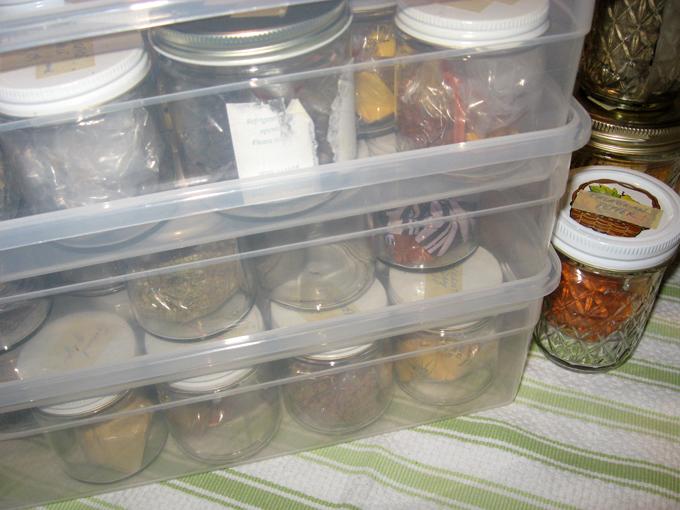-
Posts
1,729 -
Joined
-
Last visited
Content Type
Profiles
Forums
Store
Help Articles
Everything posted by djyee100
-
It might be specific Australian terminology. I've never seen it before in a Chinese restaurant, East or West coast in the US. However, I believe long noodles, in soup or stirfry, are supposed to signify long life. Maybe that's why "long" noodles are important. One is never supposed to cut the noodles--that's like cutting your life short. Once I and others were assisting a traditional Chinese chef at a cooking class. He made a stirfry with long noodles. No way we could quickly serve samples of those noodles to the class without cutting them. A couple of us blocked the chef's view of the counter while one person did some quick work with the scissors.
-
That's a tough herb to get rid of. It's so assertive that a little goes a long way. I suggest giving away your extra oregano to people who will appreciate it. You could also try Peter Reinhart's recipe for Oreganato bread. An adapted recipe, here: http://www.thefreshloaf.com/recipes/strombolini Somebody else was making a pizza crust with that dough. Now that's interesting. http://tqsrecipes.blogspot.com/2010/06/oreganato-pizza-crust.html I recently tried Sauteed Lamb Chops with Marjoram and White Wine, a recipe that's in James Peterson's new Meat cookbook. The marjoram pairs with lamb remarkably well. Oregano is similar to marjoram, so you could give it a go if you felt like experimenting. A close version of that recipe is here on Googlebooks, page 504. http://books.google.com/books?id=EWSVpBheCnYC&pg=PT531&lpg=PT531&dq=peterson+lamb+chops+marjoram+white+wine&source=bl&ots=gSHuPjjtHF&sig=Ow-J1LVnZcNnGd4v_yANp6HmOd0&hl=en&ei=yhSZTfexMq_ZiAKC9JmdCQ&sa=X&oi=book_result&ct=result&resnum=1&sqi=2&ved=0CBQQ6AEwAA#v=onepage&q&f=false
-
I've only tried mustard oil once, in a fish pitika dish from Assam. I think mustard oil is an acquired taste. Some people love it, some people hate it. Substituting for it may have been a good idea. I bought my mustard oil in a Middle Eastern store. Also, I was told to cook the mustard oil at high heat for about a minute, to detoxify it. A couple Indian lamb recipes for you, from a chef named Ruta Kahate. The recipes are in her cookbook, 5 Spices, 50 Dishes. I haven't tried these two recipes, though I've cooked many of her other recipes and I've liked her food for years. A word of caution about salt in the book's recipes: it's for kosher salt, not sea salt (though it doesn't specifically say), so adjust the amount accordingly. Roasted lamb with burnt onions: http://books.google.com/books?id=PFkCt6kQNIEC&pg=PA57&lpg=PA57&dq=ruta+kahate+lamb&source=bl&ots=2YgVD3pPs0&sig=ohSkRAaab_guXJPjcdLxmGpFYaI&hl=en&ei=9q2YTYCTIIP2tgPhk5zIBQ&sa=X&oi=book_result&ct=result&resnum=1&sqi=2&ved=0CBQQ6AEwAA#v=onepage&q=ruta%20kahate%20lamb&f=false Lamb chops with spicy rub: http://www.epicurean.com/featured/lamb-chops-with-a-spicy-rub-recipe.html ETA: Oho. When I scroll down in the first link on Googlebooks, I get the recipe for Lamb Meatballs in Spicy Malabari Curry. Now that's a recipe I've cooked, more than once, and it's one of my faves. The meatballs taste good with ground chicken thigh meat too.
-
I notice that this board is under Spirits & Cocktails, and as far as oranges go, I can't help you there. But about those oranges in general... I suggest you grab more of those blood oranges. They are a spectacular fruit for both sweet and savory dishes, with a sweet, subtle flavor and an eye-catching raspberry color. They're memorable in a sorbet. I recently ate a salad of blood oranges, thinly sliced fennel, red onion, and olives--a Mediterranean classic--and I can recommend that. Blood oranges can probably be substituted for naval oranges in most dishes. This salad: http://www.finecooking.com/recipes/fennel-orange-salad.aspx The seville oranges are best for marmalade. I've never tried one (that I remember). Someone I knew had access to an orchard of them, and she made a face when she mentioned how they tasted fresh. Not an eating orange, as far as I know.
-
I thought, Where did she get porcupine meat? It's still the AM here. I need another cup of coffee.
-
There's plenty of scent in dried rose petals if you just sniff 'em. I don't know what's left after they've been cooked with meat. However, it's the rose essential oil in both fresh and dried roses that gives off the scent, so I would guess fresh and dried roses are somewhat interchangeable. In my experience, most recipes that call for rose scent in cooking use rose water. A food-safe rose essential oil is also possible. Where are you buying your dried rose petals? Good spice suppliers have herbalists on staff who might know, especially if the herbalist is a dedicated cook also. (Many herbalists I've met are serious cooks.)
-
Dcarch, I do enjoy your creations. I also spend a lot of time looking at your photos and asking myself, Now how was that done? So... For the purple cabbage rose, how was that done? It looks like the whole cabbage was cooked, the outer leaves peeled down (very carefully, I would guess), and the top part of the cabbage cut flat. Did you do anything special to the base so that the cabbage would sit just so? Some hints or explanation, please. ETA: I like those green pepper 4-leaf clovers. They're going on my next St Paddy's Day dinner.
-
Dans, The bread you are searching for may be the "Country White Bread" from the The Greyston Bakery Cookbook (1986 edition). Believe it or not, it's a potato bread, but doesn't taste like potato. The potato only makes the bread richer. It has the crust you describe, and it's great for sandwiches and rolls. The counterpart to the Greyston Bakery on the West coast, the Tassajara Bakery in SF, sold it as "Potato Bread." As I mentioned, the recipe is in The Greyston Bakery Cookbook as "Country White Bread." A nearly identical recipe is in The Tassajara Recipe Book (2000 edition) as "Potato Bread." The Tassajara version calls for 2 tsp salt, the Greyston version for 1 TB salt; the Tassajara version for 1 1/2 pkgs yeast, the Greyston version for 2 pkgs yeast. There are slight differences in method, also. When the Tassajara Bakery was still around, I bought many loaves of potato bread there, and it was a great favorite of the bakery's customers. I've baked both the Tassajara and Greyston versions of this bread, too. To get you started, this is a very abbreviated version of the recipe from the Greyston cookbook. I suggest you get your hands on either cookbook for thorough instructions. Country White Bread 1 1/2 cups well-mashed potatoes 2 pkgs dry yeast 2 cups very warm (100 degrees F) water 3 TB honey 1/3 cup dry milk powder 1 TB salt 3 TB oil 6-7 cups unbleached white or bread flour egg wash: 1 egg beaten with 2 TB water Mash the potatoes & add up to 3 TB hot water so that the mixture is very smooth. Let cool to warm. Dissolve yeast in the warm water. Add honey, milk powder, salt, oil, and potatoes. Stir well to mix. Gradually add in the flour. Knead. Let rise until doubled in bulk. Punch down. Let rise until doubled again. Punch down, and form 2 loaves. Place the loaves in oiled pans, cover lightly with plastic wrap, and let rise until almost doubled. Brush with egg wash. With a knife, cut three diagonal slashes across the loaf. Bake in preheated 350F oven for 40-45 mins until the tops are dark golden brown and the loaves are done.
-
This old article from the NY Times chronicles Matt Lee & Ted Lee's use of lard in cupcakes and cookies (NY Times, 10/11/00). I myself haven't done much cooking with lard. http://query.nytimes.com/gst/fullpage.html?res=9C06E3DC1E3CF932A25753C1A9669C8B63&pagewanted=1
-
One last suggestion: have another sink available, like a bathroom sink, for people to wash their hands before and during cooking. Then they won't all crowd around the kitchen sink. A small damp towel underneath a cutting board will also keep it from slipping on the counter.
-
This is only my impression, but that looks more like a dinner cooked by 15 or more people within a 2 hour time frame. Am I reading the chart right, and 15 mins of prep time are allotted at 5:45PM? Even if these people are great cooks with chef-level knife skills, there are delays because they are unfamiliar with your kitchen, don't know where things are, will talk to each other as they cook, and take pictures and video as souvenirs. In my mind's eye I can see them waiting to use the sink as dishes and pans pile up there too. Years ago I assisted a wonderful Indian chef named Ruta Kahate when she gave classes in her home. Ruta gave the best hands-on cooking classes I have ever attended. This was her system: - The ingredients were premeasured, in bowls, and set on a half-sheet tray. Knives, utensils and other tools that would be needed were set on the tray too. - The pots and pans for cooking each recipe were set out on the counter for easy access. Question: do you have a system for dealing with the pots, pans, bowls, knives, etc as they get dirty? What if some of these pans and knives must be reused for another recipe? - For complicated recipes, we often did most of the prep ahead of time and put it on the tray. We left token amts for people to do some "hands-on" like chop an onion or peel & devein shrimp. Ruta's priority was not the knife work or prep. So what if the chopped onion is a little scuzzy? If people keep up with cooking, their knife skills will improve. - Ruta's strength, which too few hands-on cooking teachers do consistently, was to stay by the stove and watch over people's shoulders while they cooked. In my experience, that's when people really learn to cook--they can see, smell, and hear what the food should be doing as it cooks. Ruta would stick by them and point out things to do and things to watch out for. Her presence by the stove also insured that the dish would be cooked right. I put in the emphasis because in many hands-on classes, the students are freelancing at the stove while the teacher is elsewhere, and that's where the mistakes are made. Then the students don't know how to cook the dish properly and don't know what it should taste like, either. - During class, my job was to clean up the dirty dishes and make sure the workspaces were clear for the next recipe. I helped with prep if one group seemed a little swamped, and demo-ed prep or knife techniques to a group if necessary. My presence in the rest of the room freed up Ruta's time so she could teach by the stove. If you can find someone to assist you and do these tasks, you will probably be very grateful to that person. - A reminder: safety tips to the students before they do anything. They're wearing closed shoes, right? They should be reminded to keep the knives pointed down by their sides when they walk around with knives (you'd be surprised how many adults forget that). If they're carrying a hot pan behind someone, they should warn people by saying, "hot behind!" and wiggle their asses a little. If you have other questions, ask away.
-
Ann_T, I love that bangers and mash. And it's much more true to Keith Richards' original recipe. No wonder Richards went after that kid with swords when the kid ruined his dinner.
-
It's a major consideration when I pair wine with food. The saying is only about the body and full flavor of a wine. If you paired a "lightweight" wine, like pinot grigio, with a heavy-duty grilled steak, the wine would be lost. So instead you pair a charred steak with a heavier wine like cabernet sauvignon or petite sirah. Or if you paired that cabernet sauvignon with sauteed scallops, the wine would overwhelm the delicate seafood. That's when you reach for the pinot grigio. Why did you think this was counterintuitive?
-
This sounds really interesting. Is it just wings cooked in a red sauce? I have some wings in the freezer and may give this a try. Yes. The chicken wings are simmered in the red sauce. When done, they should be soft, almost falling off the bone, but still hold their shape. Browning the wings beforehand will firm them up and add a nice touch of color when they're cooked. Made this last night and it was lovely! I totally forgot to season the wings before browning them, but they still turned out quite well. Will definitely add this to my regular rotation. I'm so glad you liked it. I clipped the recipe from the newspaper years ago. It was part of an article. The author's grandmother, an Italian immigrant who lived through the Great Depression, used to wheedle free chicken wings from her butcher as a bonus for her regular order. Then she made an extra dinner out of the free wings.
-
This sounds really interesting. Is it just wings cooked in a red sauce? I have some wings in the freezer and may give this a try. Yes. The chicken wings are simmered in the red sauce. When done, they should be soft, almost falling off the bone, but still hold their shape. Browning the wings beforehand will firm them up and add a nice touch of color when they're cooked.
-
I bought fresh sausages labelled "pork bangers" at my local Whole Foods. Any mild pork sausage will do. ETA: I parcooked the sausages with a little water in the skillet to even out the cooking time with the onions and bacon. That's something to watch out for.
-
Mmm, the keema matar and tacos look delicious. The recipe for dinner here came from an unusual source, Keith Richards of the Rolling Stones, via his new autobiography, Life. I recently finished the book. Besides fascinating accounts of the rock scene, world fame, harrowing drug addiction, and musicmaking, Richards reveals that he cooks for himself because of his erratic hours (dinner at 3AM) and gives his recipe for traditional British bangers and mash. I decided to give the recipe a go. The recipe says to cook the sausages with onions and bacon. I kinda did this. To cook the sausages, I set them in a skillet with a little water over high heat. When all the water had evaporated and the sausages were sizzling in their fat, I tossed in the onions and bacon pieces, lowered the heat to medium, and let everything cook until the onions were soft and caramelized. There were yummy brown bits in the skillet, so I deglazed the pan with a little white wine. (The British do this, don't they?) When I got to the mashed potatoes part, I felt like eating parslied potatoes. I tossed hot cooked potatoes (Yukon Golds) with olive oil and parsley, let it all sit for awhile, then finished it off with champagne vinegar and salt. No peas in the house, so I opted for some fresh kale delivered by my CSA yesterday. I sauteed the kale with garlic. The result, bangers and "mash" that took a detour through California. It tasted good. In his book Richards tells how one of his son's friends swiped the raw onions while he was cooking a late-night snack of bangers and mash for himself. The boy thought it was a good joke. Richards thought differently. He tore down two decorative sabers from his mantelpiece and ran off into the night after the miscreant. Never caught him, though. Really, it is annoying when someone bothers you while you're cooking. Richards' original recipe is here. http://mysticrock.blogspot.com/2010/11/keith-richards-bangers-mash-recipe-feat.html
-
Your points are well taken. However, as I see it, the two issues are not exactly analogous. It's probably true that shark finning has less effect on our environment than meat production. One could argue that both practices have an inhumane component. However, shark finning has resulted in a decrease in the worldwide shark population. I would say shark finning is analogous to the irresponsible hunting of buffalo or the dodo bird in previous centuries, with severe depletion or extinction of the species. To me, that's the issue here.
-
Same here. I keep my spices in clear shoe boxes, grouped alphabetically. More or less. All the spices are kept on a shelf in a cabinet. I buy my spices in bulk at a local store, in small quantities. If I haven't bought too much, I can stuff the baggies in the small jars, which I buy separately. I reuse sturdy jam and jelly jars, too. Any extra spices are kept in a canister for refills. If I had an extra shallow drawer to spare, I could use the shoe boxes like separators or trays. But I don't, so I stack them in the cabinet like this. Since they're alphabetical (more or less), I know which shoe box to aim for. BTW, I think storing the spices in a cool, dark cabinet keeps them fresh longer. The labels are very high-tech, masking tape & ballpoint pen.
-
Chicken wing spaghetti sauce. The wings add flavor to the sauce and make for good eating with your fingers. Wish I could take credit for the idea, but somebody's Italian grandmother thought of it first.
-
Does Murdock expect to keep his mental faculties for the long haul also? A friend and her husband are now caring for his parents, well into their 90s and living in a rest home. His parents were always very careful about diet and exercise. Their doctors say their physical health is excellent. The problem is, they have alzheimer's and don't recognize or remember anyone, including their own children. My friend said that observing her husband's parents has changed her mind. She said, "I'm not going to be so obsessive about what I eat anymore. What kind of life is it when you have no mind? I'm going to eat what I like, and I hope my family's cardiac gene takes me out in my 80's." A tip of the hat to David Murdock, for his ambition. But that's not necessarily how the rest of us want to live, no matter how long.
-
Sorry if I'm going off thread with this. Nevertheless, the problem remains. As long as the nests are removed, the birds will continue to cough to build nests. If anything, these birds are less protected than birds in the wild. Supposedly in a wild harvest the birds must be left alone once a certain number of bloody nests is reached. There appear to be no such protections here. Another part of the problem: in the wild, these birds always return to the same nesting place. No one knows how the farmers attract and keep the birds coming to the structures, but that returning instinct may play a part. IOW, the birds are compelled to nest in a certain place, and continue to cough up saliva to build nest after nest, even to the point they cough up blood.
-
I agree with others on this board. No food is sacrosanct, especially when the harvesting practice is causing a decrease in shark populations worldwide. It's true that this particular ban affects the Chinese community, but it's not aimed at the Chinese community. If Poles ate shark's fin soup, Poles would be affected. Swallow's nest soup might be the next traditional food to go down. Harvesting in the wild is supposed to be regulated by counting how many bloody nests the birds literally cough up. The birds keep building nests as people take them away. Eventually the birds become so stressed that they cough up blood with the saliva for nestbuilding. Too many bloody nests over a certain number, and people are deemed to be overharvesting. The fact that any birds are reduced to coughing up blood to build their nests, as they are compelled to do by instinct, troubles me. As with shark's fin, we're talking about a gelatinous, expensive delicacy. I'd welcome faux bird's nest, too.
-
I always thought the quality of the "bread lip" was determined by the depth, angle, and length of slash, and not much else. My first impression when I saw the loaves in the OP: the bread on the left was slashed with a more shallow cut. Ideally, the slash should bake into an overleaf, a fold above the loaf. Bigger is not always better. Slashing is beautiful, but its purpose is to even baking as gases are released, and to give an even, symmetrical shape to the loaf. Yes?
-
For crispy pastry over a moist filling, bake the pastry separately and put on the pastry strips or caps right before service. I once saw Joyce Goldstein illustrate this method. She made chicken pot pies in ramekins, only the filling (no bottom crust), and baked little circles of pastry separately on a sheet pan. Before service she topped each ramekin with a crisp pastry circle. She specifically said she followed this method because she doesn't like soggy pastry. Another cooking teacher once told me to brush a raw pastry shell with egg white, then bake it. The egg white forms a veneer on the pastry that repels moisture. You don't taste the egg white. I've never tried this method myself. I did taste a quiche made by this method, and I thought the crust was pretty crisp.







